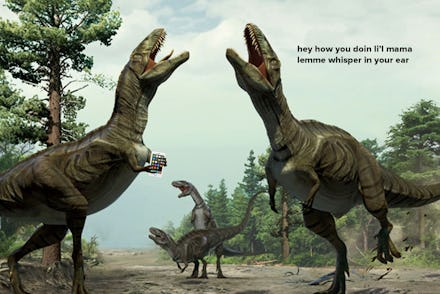Dinosaurs Probably Did This Freaky Dance to Get Laid, Just Like You in College

According to new research, our dinosaur friends probably engaged in some fancy footwork to snap up a mate, just like us at that freshman-year rager.
A team of scientists has come to this conclusion after studying a series of "large-scale scrapes" — fossilized imprints produced from the left and right feet of dinosaurs — at sandstone sites in Colorado. They described the scrapes as having "parallel double troughs, comprised of multiple scrapes separated by a raised central ridge."
According to the report, researchers have long suspected that dinosaurs and birds shared similar mating rituals. Until now, however, there has been little in the way of physical evidence to support such a theory.
"These scrapes can be interpreted as the missing physical evidence which indicates that non-avian theropods engaged in stereotypical avian courtship and lek-like behaviors, which were previously only a matter of speculation among paleobiologists," the researchers wrote in Scientific Reports, an open-access journal published by Nature.
The largest scrape site showed roughly 60 scrapes on just one patch of sandstone. The site itself was about 50 meters long and 15 meters wide. (Dinosaurs have us on the scope of their mating sites, apparently.)
The authors also ruled out other sources for the evidence, including theories that the scrapes were nest sites or colonies; the products of food-, water- or shelter-related digging; territory markers or "nuptial display arenas." They pointed to other creatures, like the Atlantic puffin, that perform similar rituals before preparing for the bone zone.
As David Norman at the Conversation points out, fossilized evidence is a notoriously tricky area for paleontologists. "Trying to tie the identity of fossilized tracks to the original track-maker has been a persistent problem," Norman writes. "It's rather like the hunt for Cinderella."
But in recent years such evidence has gained new respect due to the information it can produce. "Local environmental conditions when the tracks were made, the texture of the sediments that the creature was walking upon and the details of foot placement, stride length and stride pattern" can all help researchers, according to Norman, who works as a curator of paleontology at Cambridge University's Sedgwick Museum of Earth Sciences.
Just imagine it: A college party in a sticky, beer-drenched, foul-smelling fraternity house. Dozens of sweaty early-20-somethings clad in short dresses, cross-body bags, baggy jeans and sweatshirts. Remix after remix of "Sail" by Awolnation blasting through the speakers while a DJ frantically gesticulates in front of a table.
Suddenly, a roar breaks out, and before you know it, that Tyrannosaurus rex from down the hall is stomping its feet and eyeing a classmate. You can already guess what's about to happen: They're about to switch to Marvin Gaye and get it on. Or, you know, whatever the dinosaurs actually did in addition to their scraping and mating rituals. We'll just have to wait until the next batch of fossils is discovered.
h/t IFL Science